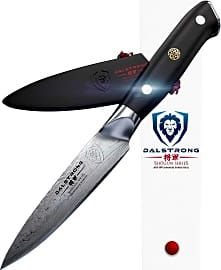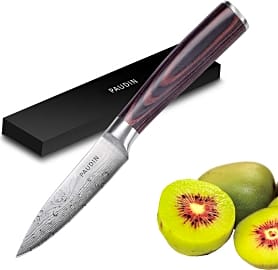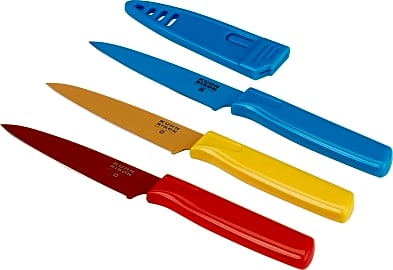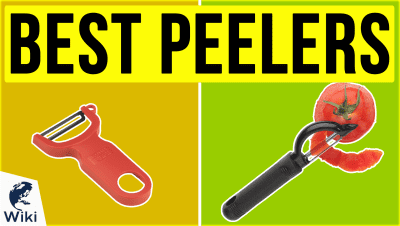The 10 Best Paring Knives

This wiki has been updated 42 times since it was first published in September of 2015. Anything from our selection of paring knives is ideal for peeling fruits and vegetables and other intricate work, such as deveining shrimp, removing the seeds from a jalapeño, slicing mushrooms, or creating thin slices for garnishes. Since they’re a staple in every kitchen, we've included models priced for home cooks along with hardwearing options designed for professional chefs. When users buy our independently chosen editorial selections, we may earn commissions to help fund the Wiki.
Editor's Notes
December 16, 2020:
Most of the paring knives on our list are still great choices, so most remain. We’ve switched out only two for this update, the Global Western and the Zelite Infinity, both good knives, but we found ones we recommend even more strongly. The diminutive Dexter Russell acts like a very sharp extension of your hand, and is often found in busy restaurants or catering kitchens. The colorful Kuhn Rikon knives might seem too cute to take seriously, but they’re a great size, have flexible blades, and come in a group of three so you won’t have to wash and dry a single tool during prep of different ingredients.
We’re still very fond of the highly affordable Victorinox Swiss Army. The slender blade won’t get stuck like thicker knives, and for jobs you want to pick up off a cutting board, it does the trick because it maneuvers well. Its appearance is much plainer than many others on our list, but it’s a very impressive kitchen helper.
No matter how well you treat your knives, they’ll eventually need sharpening. Not sure if manual or automatic is right for you? A little knife sharpener research should do the trick.
May 31, 2019:
Just because it's inexpensive doesn't mean the Victorinox Swiss Army isn't an excellent knife. It's comfortable to hold with a blade that's perfectly-shaped for delicate tasks, but it can still cut an apple in half or mince a few shallots or garlic cloves. It may not last as long as higher-end options, but it's so affordable that you won't mind replacing it every couple of years. The Mac Professional PKF-30, on the other hand, is built to last. It's razor-sharp with a hardened blade that holds its edge very well and excels both on and off the cutting board. The Mercer Culinary Genesis is both durable and affordable, with a nonslip grip that can take a lot of abuse, and it's NSF-certified for commercial use. The Henckels Four-Star and Wusthof Classic are both made from high-quality German steel with precise pointed tips and hardened blades that retain their sharpness well. The Rada Cutlery Brushed Aluminum is a great starter set for casual cooks, with three different sizes of blades designed for light, medium, and heavy jobs. However, their handles are very slim, which can be uncomfortable for users with large hands.
Special Honors
Misen Paring Knife With a name deriving from the French cooking term “Mise en place,” Misen knives are high-quality with thoughtful design, but won’t cost an arm and a leg. Do watch out for fingers, however, as these are very sharp right out of the box. misen.com
An Important Addition To Any Kitchen
For a wide range of intricate tasks, chefs around the world turn to the highly versatile paring knife.
Many chefs will tell you that playing with flames and sharp things is the most fun part of their job. For some, that was the specific reasons they started working in the culinary field. And it's obvious that few tools are as crucial to cooking as a good knife.
But not all knives have fat, six-inch long blades. Not all of them are suited for slicing prime rib roasts or carving turkeys. And the fact is, there are many kitchen tasks that require a level of attention and accuracy that can't be achieved with a serrated slicer or a heavy German chef's knife. For a wide range of intricate tasks, chefs around the world turn to the highly versatile paring knife.
It's a common misconception that these knives got their name because they cut whole pieces of food into pairs. They carry that title because they pare down excess material from foods, reducing them to smaller pieces.
These are small knives, between about three and four inches long. Very often, the handle will actually be longer than that. These short steel blades are shallow from spine to edge, no deeper than 3/4 inches. The entire setup is designed to fit easily in the palm of your hand. This allows you to use your thumb and forefinger freely to guide the small foods you're working with, lending great precision to your work.
What's In A Knife?
The vast majority of paring knives on the market are made of steel. The few exceptions to that are some ceramic options, but those are difficult to sharpen and very prone to chipping and breaking. For that reason, they should generally be avoided.
Like with many other kitchen knives, you'll run into two general styles of paring knives: western and Japanese. These differ in two important ways: geometry and materials. Not only are Japanese knives more smoothly tapered to a point, their blades are thinner and their edges are ground at a more acute angle. Western models, specifically knives from German makers like Wüsthof, tend to have a broader heel, and their taper is more sudden and begins closer to the point.
Not only are Japanese knives more smoothly tapered to a point, their blades are thinner and their edges are ground at a more acute angle.
Eastern knives are often made with harder steel alloys. This allows for lighter, thinner blades that are more maneuverable and can hold an edge longer, but require a bit more care to use and may be prone to nicks. French and German styles have heavier blades made of slightly softer steel, which makes them more suitable for many heavy-duty tasks (somewhat counterintuitively). For example, it's not recommended to work with tough foods like winter squash, sweet potatoes, or seed pods using more brittle, harder alloys. And you'd never want to use a traditional Japanese chef's knife to split bones for marrow.
Overall, the softer, western-type knives are much easier to maintain than high-hardness pieces and can get usually get just about as sharp. Moderate honing is all they need on a daily basis, and they're fairly resistant to chips and turned edges.
A lot of the fancier, more expensive paring knives have dense handles with attractive finishes. Some of these will provide better grip in wet or oily conditions, and some feature attractive, handcrafted designs. Both stainless and carbon steel models are available with different types of cladding and chemical resistance to oxidation.
You'll notice that some high-end options have prominent bolsters designed to provide maximum balance and surety of cuts. But because of the small nature of paring knives, it just so happens that some of the smallest, most economical options can outperform many heftier and far more expensive choices.The simplest models consist of narrow handles made of textured, high-impact plastic.
You'll find yourself most often using the paring knife in the air and not on the counter, so a low-profile handle helps to add control and safety to your cutting. The blades of these inexpensive options are narrow, maneuverable, and easily sharpened, and they're readily available at affordable prices. This makes them perfect for stocking an entire kitchen in need of precision tools.
So Small A Blade, So Much Possibility
Because of its small size, the paring knife has a wide range of uses and is a definite necessity in any chef's toolkit. This versatile item cores tomatoes with ease or shaves paper-thin slices of garlic. It's the perfect knife for removing stems and cleaning strawberries. Potato eyes are no match for the paring knife's small and easily maneuvered blade. Devein shrimp or prepare fine garnishes with the right variety of these diminutive cutting tools.
This versatile item cores tomatoes with ease or shaves paper-thin slices of garlic.
Everybody loves a stuffed pork loin or chicken breast. A razor-sharp, 3-inch knife is perfect for making a quick incision into a piece of high-quality meat, making room for delicious, cheezy, breadcrumb-filled goodness. Paring knives even work in place of a peeler in a pinch, letting you strip the hard rind from a squash or a melon without straining or cutting yourself.
In high-end kitchens, you'll see talented chefs using incredibly sharp paring knives for the intricate carving of vegetables. Classic designs like green onion tassels, chili pepper flowers, and tomato rings add visually creative and flavorful elements to a dish. You can even find sheaths for your paring knife that strap right to your belt. This way you have instant access to this incredibly useful tool at a moment's notice, no matter where in the kitchen you are or what you're doing.
With so many different functions, these are truly essential items to any home or professional cook. Just make sure to clean and maintain yours as thoroughly as you would any important kitchen tool. This will ensure the knife's long life as well as your fingers' safety.















